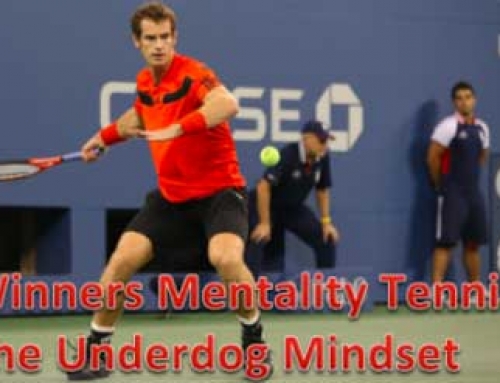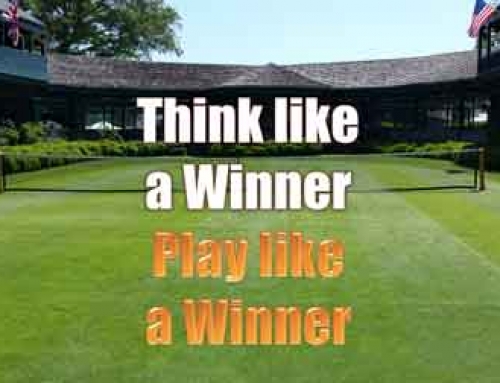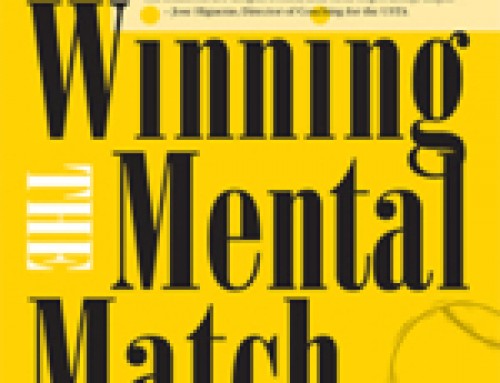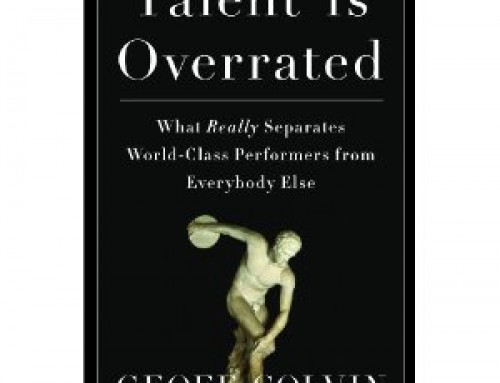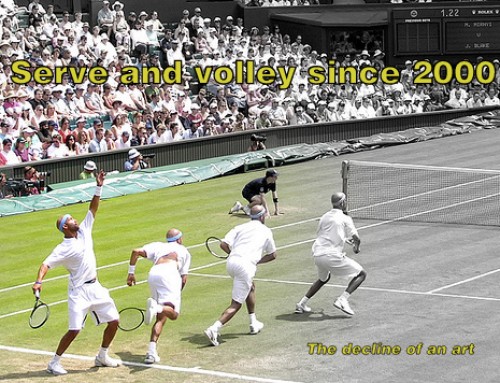 “Fear not the racket, but the player who wields it.” -A martial arts weapons philosophy showcased in the movie Ninja Assassin, and modified for the game of tennis
“Fear not the racket, but the player who wields it.” -A martial arts weapons philosophy showcased in the movie Ninja Assassin, and modified for the game of tennis
“Most of what I teach comes right out of the martial arts – the physics, the fundamentals, the self-discipline – and your mind is your greatest weapon.” –Coach John Nelson, Univ. of Hawaii Men’s Tennis Program, College Coach 26 years, Master’s Degree in Education, 3rd degree Black Belt in Ju Jitsu
I. Introduction: The Brother Disciplines
Since the Bruce Lee movies of the 1970s, the self-discipline of the Martial Arts has captured the public’s imagination. Watching empty hands and feet used as lethal weapons at lightening speed, powered only by the mind’s will, hypnotized modern fans and observers.
The term “martial arts” actually means the “art of war.” And the term can be traced back to the Roman God of War, Mars. Chinese martial arts date back 4000 years ago to the Xia Dynasty. Martial arts is widely considered however both an art and a science. Many forms of martial arts are linked to religious beliefs such as Confucianism or Daoism or follow a code of honor. The purpose of martial arts is self-defense or defense of others. More broadly however, the goal of martial arts is to offer its students self-knowledge and a better understanding of man and nature.
The forms of the martial arts are varied and far-reaching. They are primarily found in the Far East (Japan, Korea, China). But they also touch the Middle East, South Asia and even the Americas and Europe: Ju Jitsu, Karate, Aikido, Judo, Kung Fu & Tai Chi, Tae Kwon Do, Ninjutsu (Ninja fighting), Jeet Kune Do (hybrid form), Pentjak Silat (Thai martial arts), Kalari (Indian martial arts), Hikuta (Egyptian martial arts), Capoeira (Brazilian martial arts dance), Open-handed wrestling (Native American martial arts), Savate (French Kickboxing), and others.
All the martial arts share some common characteristics, among them: balance, posture, control, flexibility, timing, hand-eye-foot coordination, aggression, grace, power, agility, speed, strategy, tactics, and more. Indeed, many of these elements are shared with many other sports and activities such as soccer, basketball, football, even archery.
This article will focus however on aspects of the martial arts which make it unique, and relate them to the game of tennis. These key elements help remind tennis players of the vital parts of our own developing game. And they show how accomplished martial artists and high-level tennis players are learning and refining their craft on a shared platform with common goals – they are truly “brothers-in-arms.”
II. The “Chi” is Universal and The Core is “King”:
In martial arts, it is believed that there is a universal energy or “chi” in all things. “Chi” is thought to be the source of all power and fluidity in martial arts strikes. In the human anatomy, the universal energy is believed to be centered in the navel. In tennis, the human core or trunk is the ultimate source of power and energy into the ball from strokes.
In tennis, power emanates from the ground up. It is created through well-timed use of the kinetic chain from feet, legs, hips, trunk, arms, hands, racket, all applied into the ball. Many call this “core rotation” in high-performance tennis. Compare this with the roundhouse kick in for example Tae Kwon Do. The roundhouse kick rises from the ground in a springing action, the legs and hips pushing through in an acrobatic move, resulting in a well-timed application of force towards the opponent.
The kinetic chain in tennis and the Chi energy release of martial arts are really two forms of the same process – gathering or coiling energy, and then releasing or uncoiling it, either at the tennis ball or at the martial arts opponent. The human anatomy’s coil-and-uncoil mechanism seems to have three axes points: at the shoulders, the hips and the knees. These same human axes points are used in many martial arts strikes.
To maximize the flow of energy and thus power, the marital arts also emphasizes “punching through the strike”. This means visualizing your arm or leg literally pushing through the opponent. In comparison, tennis emphasizes “hitting into and through the line of the shot”, and extending your stroke follow through or finish towards your target.
III. The Universe is Balanced, Rhythmic and Harmonious
For the martial arts, there is a balance, rhythm and harmony to all things in nature. And nature is a source of inspiration. Indeed, many martial arts strikes are in fact taken from the moves of the animals. Kung Fu for example is divided into animal styles (real and mythic): the snake, panther, tiger, crane, and dragon. Fighting styles in Kung Fu include, among others: the praying mantis and the drunken monkey.
One of the keys to the martial arts is the concept of balance and centering of the human body. The Ninja fighters of the discipline of Ninjitsu for example are legendary for their balance skills. They are known to practice their strikes on a balance beam. Similarly, the art of Aikido focuses on the body’s center, and teaches that all power and control protrudes from that center in a relaxed state.
Martial arts is essentially a rhythmic dance of timed strikes from perfect postures. For example in Karate, the kata is a precise, highly-defined and pre-determined sequence of strikes. In Tai Chi, the student learns a continuous pattern of postures that actually form a dance. Countless repetitions of the martial artist’s moves develops timing, rhythm and cadence. Bruce Lee once remarked: “I fear not the man who has practiced 10,000 kicks once, but the man who has practiced one kick 10,000 times.”
Consider that, in tennis, some of the keys to high-level performance are the same: balance in stroke production, consistency in shot-making, and the rhythm that is offered by for example learning the Wardlaw directionals. Other concepts such as precise timing and good posture in stroke technique, and the value of sound repetitions of strokes, can be taken directly from the martial arts. And if martial arts exercises collectively teach a cadence or dance, then tennis teaches the cadence of the split-step in moving to the ball, which is essentially the “dance of tennis.”
For martial arts, the world is full of harmonious cycles – the changing of the seasons, the cycles of the sun and stars, and the release of human energy and exercise followed by rest and recovery. Both martial arts and tennis instruct students not only about stroke power and energy, but also about the importance of body recovery and healing. Rest, rejuvenation, ice, heat, nutrition, hydration, stretching, and massage are critical to consistent top performance in both disciplines.
IV. The Ready Position
The “get-ready-to-fight” position in martial arts and the “ready” position in tennis are amazingly the same. The feet are spread comfortably shoulder-width apart. The knees are bent. The body’s weight is on the balls of the feet. The arms and elbows are also bent and relaxed. The hands are loosely out in front. Waist, back, neck and head are straight. The student is comfortable, relaxed and ready to move.
V. Watch, Listen and Breathe
In martial arts combat, the student must utilize every form of sensory perception – sight, sound, touch. He must observe, listen and breathe. He must gauge his opponent, anticipating his next move. He must exercise self-control. He focuses on his breathing to help still his mind’s thoughts. He keeps his back straight, his body balanced, and his head stabilized. He moves like the panther and strikes like the cobra.
Compare this with the high-level tennis player in a contested match. He must continuously track the ball, keeping the head stabilized. He must continuously split-step just before the opponent’s racket contacts the ball, so as to move to it with maximum speed and efficiency, appearing to glide on the court. He should seek to hear the sound or “pop” of the ball off of his racket. He may focus on breathing to quiet his anxiety and fears. His body is balanced, back straight and head completely still. His moves are cat-like, and he seeks at first opportunity to go on the offense with his shot.
Both martial arts and tennis encompass the two polar opposite styles of execution or “schools of thought”: in martial arts, the aggressive power style vs. the steady methodical style, and in tennis, the hard court attacking game vs. clay court point construction style. In martial arts, the power style is represented, for example, by aggressive chops of Karate or the flying kicks of Tae Kwon Do. Whereas the steady methodical style is represented, for example, by the graceful flips of Judo or the circular strikes in Aikido. In tennis, professional players divide, among other ways, into groups which excel at the hard court attacking game (Andy Roddick or Taylor Dent) vs. the clay court point construction style (Rafael Nadal or David Ferrer).
VI. The Power of Smooth
The “power of smooth” refers to a relaxed confidence and an unbroken fluidity, resulting in top performance results. It’s about maximum efficiency with minimal effort. It’s about operating with a deliberate unhurried purpose, without appearing pressed or pressured by time, the opponent or conditions.
In martial arts, one noteworthy example of smooth is the discipline of Aikido – known as the “throwing art”. In Aikido, the student learns a fluid, circular and harmonious defense to an attack. The Aikido student blends in with the attacker’s moves, and returns the attack with relaxed, loose circular throws and flips. Even multiple attackers can be repelled by a confident graceful practitioner who can re-direct one opponent’s attack on a fellow attacker.
In tennis, the top professionals exhibit relaxed, loose, graceful strokes with confident purpose. They never look hurried, pressured or off-balance. Indeed, they “play the ball” and do not allow the ball or the opponent to “play them”. They play with soft hands and loose face muscles, especially at the time of split-step and just when the opponent makes contact with the ball. When faced with attacking power, they return the opponent’s power at him. When faced with opportunity such as a short ball, they are deliberate and decisive. They move forward fluidly and cut off angles gracefully.
VII. You are Always the Student Forever
In martial arts as in tennis, you are always the student forever. Coach John Nelson, 26 years college coaching, Master’s Degree in Education, and martial arts black belt, put it this way: “The more you get into the martial arts or tennis,
VIII. Victory is Vital, But in the End, More Vital is Your Growth and Passion
Winning is naturally vital in a martial arts contest or a tennis match. But victory will depend in no small part on winning the psychological test of wills against the opponent -who will impose their will on the other? Bill Tilden, in How to Play Better Tennis, wrote pointedly that in a tennis match: “One player…will ultimately impose his tennis personality on the other.” The very same is true in the martial arts.
Both martial arts and tennis are asking the student to test their own outer limits and fulfill their own highest standards. What are the limits of the student’s fatigue, fitness, endurance, flexibility, and strength? What are the student’s highest expectations of his play, his shots, his execution, his strategy, his self-discipline, and his confidence and relaxation?
The final goal, of course, is advancing to a higher level in skill and ability in either the martial arts or tennis. On that score, your worthy opponent makes you better and stronger, as does each of your valuable matches and practice sessions. And your growth and passion for the discipline of the martial arts or tennis is all that can ultimately drive you to a higher level.
IX. The Mental Contest
Andre Agassi, in his autobiography Open, wrote poignantly about the mental battle of tennis. And amazingly the very same applies to the martial arts: “Tennis is the loneliest of sports…In tennis, you’re on an island, with no clock. You can’t sit on a lead. You have to win the last point to win the match. You’re out there, you can’t talk to anybody, you can’t pass the ball, there are no time-outs. There’s no coaching, you don’t have to be good, you have to better than one person and that person is on the other side of the net.”
X. Conclusion
Martial arts and tennis share the loneliness of battle, the fight to the finish, and the solitude of victory or defeat.
Both disciplines are about hard work, self-discipline, and problem-solving.
And both are ultimately about self-knowledge, and your own highest standards for yourself.
…and they are about the lessons of life and the nature of man.
Timeless Tennis: A Blog
www.timelesstennis.net
Sources:
1. Tennis Kung Fu, by Master Bruce Wang, Ph.D. (Lulu.com, 2008)
2. The Complete Martial Arts, by Paul Crompton (McGraw-Hill, 1989)
3. Coach John Nelson, Univ. of Hawaii Men’s Tennis Program, College Coach 26 years, Master’s Degree in Education, and 3rd degree Black Belt in Ju Jitsu
4. Ron Miller, GottaPlayTennis.net, Tennis Instructor 20+ years, and former Martial Arts student of Goju Karate & Aikido



